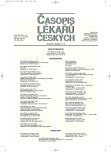-
Medical journals
- Career
Multi-marker approach in the diagnostics of cardiac diseases by protein biochip technology
Authors: M. Vašatová 1; M. Tichý 1; Horáček Jm 2,3; R. Pudil 4; L. Horáková 4; V. Palička 1
Authors‘ workplace: Univerzita Karlova v Praze, LF a FN Hradec Králové, Ústav klinické biochemie a diagnostiky 1; Univerzita obrany Hradec Králové, Fakulta vojenského zdravotnictví, Katedra válečného vnitřního lékařství 2; Univerzita Karlova v Praze, LF a FN Hradec Králové, II. interní klinika, Oddělení klinické hematologie 3; Univerzita Karlova v Praze, LF a FN Hradec Králové, I. interní klinika 4
Published in: Čas. Lék. čes. 2009; 148: 591-596
Category: Original Article
Overview
Background.
Multi-marker approach is recommended for rapid diagnostics and risk stratification of acute coronary syndrome. We tested the analytical performance of protein biochip technology for determination cardiac markers.Methods. Analysis of cardiac markers:
CK-MB mass, cTnI, myoglobin, glycogen phosphorylase BB (GPBB), heart type of fatty acid binding protein (h-FABP) and carbonic anhydrase III (CAIII) was performed by system Evidence Investigator (Randox). Analytical parameters of Cardiac array were tested. The Evidence Investigator results were compared with Elecsys 2010 (Roche) CK-MB mass and myoglobin methods. Markers of myocardial injury were determined in 28 blood donors, 28 patients with acute myocardial infarction diagnosis and 21 patients after chemotherapy containing anthracyclines (monitoring of cardiotoxicity).Results.
The Passing-Bablok regression shows statistically significant differences in results. The reasons for these differences are poor standardization of methods and discrepancies between calibrations. New substances h-FABP and GPBB are promising early markers of acute myocardial infarction and diagnostic sensitivity of h-FABP would be better than myoglobin test. These markers can be useful for monitoring of cardiotoxicity of anthracyclines.Conclusions.
In future, the use of biochip technology in cardiology diagnostic represents an important challenge but it is a necessary standardization of immunochemical methods.Key words:
protein biochip, cardiac marker, cardiotoxicity, myocardial infarction.
Sources
1. Thygesen K, Albert JS, White HD. Universal Definition of Myocardial Infarction. J Am Coll Cardiol 2007; 50 : 2173–2195.
2. Friedecký B, Engliš M, Franeková J, et al. Doporučení České společnosti klinické biochemie ke stanovení biochemických markerů poškození myokardu. Klin Biochem Metab 2008; 16 : 50–55.
3. Horacek JM, Tichy M, Pudil R, et al. Multimarker approach to evaluation of cardiac toxicity during preparative regimen and hematopoietic cell transplantation. Neoplasma 2008; 55 : 532–537.
4. Pudil R, Parizek P, Tichy M, et al. Use of the biochip microarray system in detection of myocardial injury cause by radiofrequency catheter ablation. Clin Chem Lab Med 2008; 46 : 1726–28.
5. Mair J. Glycogen phosphorylase isoenzyme BB to diagnose ischemic myocardial damage. Clin Chim Acta 1998; 272 : 79–86.
6. Pelsers MMAL, Hermes WT, Blaty JFC. Fatty acid-binding proteins as plasma markers of tissue injury. Clin Chim Acta 2005; 352 : 15–35.
7. Liao J, Chan CP, Cheung Y, et al. Human Heart-type fatty acid-binding protein for on-site diagnosis of early acute myocardial infarction. Int J Cardiol 2009; 133 : 420–423.
8. Mion MM, Novello E, Altinier S, et al. Analytical and clinical performance of a fully automated cardiac multi–markers strategy based on protein biochip microarray technology. Clin Biochem 2007; 40 : 1245–1251.
9. Vuori J, Huttunen K, Vuotikka P, et al. The use of myoglobin / carbonic anhydrase III ratio as marker for myocardial damage in patients with renal failure. Clin Chim Acta 1997; 265 : 33–40.
10. Beuerle JR, Azzazy HME, Styba G, et al. Characteristics of myoglobin, carbonic anhydrase III and the myoglobin/carbonic anhydrase III ratio in trauma, exercise and myocardial infarction patients. Clin Chim Acta 2000; 294 : 115–128.
11. Collinson P, Pulkki K, Suvisaari J, et al. How well do laboratories follow guidelines on cardiac markers? The Cardiac Marker Guideline Uptake in Europe Study. Clin Chem 2008; 54 : 448–449.
Labels
Addictology Allergology and clinical immunology Angiology Audiology Clinical biochemistry Dermatology & STDs Paediatric gastroenterology Paediatric surgery Paediatric cardiology Paediatric neurology Paediatric ENT Paediatric psychiatry Paediatric rheumatology Diabetology Pharmacy Vascular surgery Pain management Dental Hygienist
Article was published inJournal of Czech Physicians

Most read in this issue- Assessment of health state and working capacity of people suffering from locomotive system diseases
- Children in the risk of metabolic syndrome
- Pathological gambling – a pilot study of treatment effects
- Multi-marker approach in the diagnostics of cardiac diseases by protein biochip technology
Login#ADS_BOTTOM_SCRIPTS#Forgotten passwordEnter the email address that you registered with. We will send you instructions on how to set a new password.
- Career

